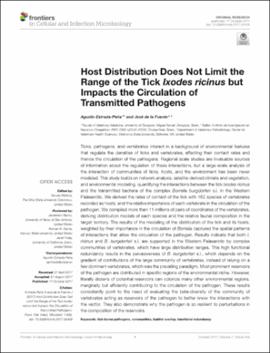| dc.contributor.author | Estrada-Pena, Agustin | |
| dc.contributor.author | de la Fuente, Jose | |
| dc.date.accessioned | 2019-08-28T16:00:42Z | |
| dc.date.available | 2019-08-28T16:00:42Z | |
| dc.date.issued | 2017-10-11 | |
| dc.identifier | oksd_estradapena_hostdistributio_2017 | |
| dc.identifier.citation | Estrada-Pena, A., & de la Fuente, J. (2017). Host distribution does not limit the range of the tick Ixodes ricinus but impacts the circulation of transmitted pathogens. Frontiers in Cellular and Infection Microbiology, 7. https://doi.org/10.3389/fcimb.2017.00405 | |
| dc.identifier.uri | https://hdl.handle.net/11244/321356 | |
| dc.description.abstract | Ticks, pathogens, and vertebrates interact in a background of environmental features that regulate the densities of ticks and vertebrates, affecting their contact rates and thence the circulation of the pathogens. Regional scale studies are invaluable sources of information about the regulation of these interactions, but a large-scale analysis of the interaction of communities of ticks, hosts, and the environment has been never modeled. This study builds on network analysis, satellite-derived climate and vegetation, and environmental modeling, quantifying the interactions between the tick Ixodes ricinus and the transmitted bacteria of the complex Borrelia burgdorferi s.l. in the Western Palaearctic. We derived the rates of contact of the tick with 162 species of vertebrates recorded as hosts, and the relative importance of each vertebrate in the circulation of the pathogen. We compiled more than 11 millions of pairs of coordinates of the vertebrates, deriving distribution models of each species and the relative faunal composition in the target territory. The results of the modeling of the distribution of the tick and its hosts, weighted by their importance in the circulation of Borrelia captured the spatial patterns of interactions that allow the circulation of the pathogen. Results indicate that both I. ricinus and B. burgdorferi s.l. are supported in the Western Palaearctic by complex communities of vertebrates, which have large distribution ranges. This high functional redundancy results in the pervasiveness of B. burgdorferi s.l., which depends on the gradient of contributions of the large community of vertebrates, instead of relying on a few dominant vertebrates, which was the prevailing paradigm. Most prominent reservoirs of the pathogen are distributed in specific regions of the environmental niche. However, literally dozens of potential reservoirs can colonize many other environmental regions, marginally but efficiently contributing to the circulation of the pathogen. These results consistently point to the need of evaluating the beta-diversity of the community of vertebrates acting as reservoirs of the pathogen to better know the interactions with the vector. They also demonstrate why the pathogen is so resilient to perturbations in the composition of the reservoirs. | |
| dc.format | application/pdf | |
| dc.language | en_US | |
| dc.publisher | Frontiers Media | |
| dc.rights | This material has been previously published. In the Oklahoma State University Library's institutional repository this version is made available through the open access principles and the terms of agreement/consent between the author(s) and the publisher. The permission policy on the use, reproduction or distribution of the material falls under fair use for educational, scholarship, and research purposes. Contact Digital Resources and Discovery Services at lib-dls@okstate.edu or 405-744-9161 for further information. | |
| dc.title | Host distribution does not limit the range of the tick Ixodes ricinus but impacts the circulation of transmitted pathogens | |
| osu.filename | oksd_estradapena_hostdistributio_2017.pdf | |
| dc.description.peerreview | Peer reviewed | |
| dc.identifier.doi | 10.3389/fcimb.2017.00405 | |
| dc.description.department | Veterinary Pathobiology | |
| dc.type.genre | Article | |
| dc.type.material | Text | |
| dc.subject.keywords | ixodes ricinus | |
| dc.subject.keywords | borrelia burgdorferi | |
| dc.subject.keywords | tick-borne pathogens | |
| dc.subject.keywords | communities | |
| dc.subject.keywords | habitat overlap | |
| dc.subject.keywords | functional redundancy | |
